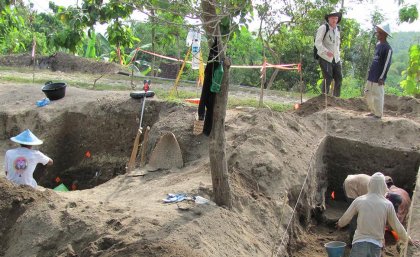
Ninety years after Dutch geologists excavated human fossils in central Java, scientists finally have pinpointed the fossils' age at around 120,000 years.
In a study reported today in Nature, The University of Queensland’s Associate Professor Michael Westaway and Professor Jian-xin Zhao helped to establish the age and a new chronology for “a critical site for understanding the later stages of human evolution”.
“This tells us Homo erectus lived to Australia's north just before Homo sapiens arrived on the Australian continent 65,000 years ago,” said Dr Westaway, from UQ’s School of Social Science.
“The dates we have now established provide no evidence for Homo sapiens and Homo erectus overlapping in time at that location. This is a very important result.
“Palaeoanthropologists have argued for years that Homo erectus may have had some genetic contribution to modern human populations migrating through the region, but there is no fossil evidence supporting this,” he said.
The new age ranges also indicate that there was no chronological overlap between the two species.
Between 1931 and 1933, geologists Oppenoorth and ter Haar discovered the remains of 12 Homo erectus skull caps and two lower leg bones on the banks of the Ngandong river in Central Java.
“These fossils do represent the youngest examples of Homo erectus, but they may also represent an important evolutionary change,” Dr Westaway said.
Modern genetic research in Indonesia and Papua New Guinea showed there were probably two lineages of another ancient hominin population called the Denisovans.
“The new age estimates from Ngandong indicate that Homo erectus and the Denisovans probably overlap in the region, or at least met at some time before 100,000 years ago,” he said.
“This may mean some of the unique traits that have been recognised in the skulls of very late Homo erectus fossils at places like Ngandong may in fact be a result of a mixture of two archaic populations – Homo erectus and the Denisovans.”
Techniques used in past investigations of the Ngandong burial sediments had made precise dating difficult.
Dr Westaway said new dating methods used in the latest study indicated that Homo erectus most likely went extinct in the middle of the last interglacial phase, when warm, rainforest environments were widespread.
“This discovery has wide implications for human evolution in island southeast Asia, and is critical for our understanding of hominin arrivals, interbreeding and extinctions,” he said.
The study resulted in 52 new ages, indicating the Ngandong river deposit and fossils were laid down between 117-108,000 years ago.
Lead author Associate Professor Kira Westaway (no relation) from Macquarie University said the site’s age had been uncertain since it was first excavated, prompting the team’s new approach.
“Previous attempts had always focused on the fossils themselves, which was problematic, so instead we looked at dating the sediments that the fossils were buried in,” she said.
Dr Kira Westaway said the study showed important discoveries could flow from reliably establishing the age of key fossil sites.
“By clarifying the age range and putting it into the context of the changing fossil record and new DNA research, it is possible to arrive at an entirely new position of understanding in human evolution,” she said.
The study was led by Institute of Technology, Indonesia, Macquarie University and University of Iowa.
Last appearance of Homo erectus at Ngandong, Java, 117,000–108,000 years ago is published today in Nature.
Video of the archaeologists working on the Ngandong site can be downloaded here.
Dr Kira Westaway explains the research in this video:
Media: Associate Professor Michael Westaway, +61 (0)420 784 593, m.westaway@uq.edu.au, Associate Professor Kira Westaway, +61 424285977, kira.westaway@mq.edu.au
.jpg)









